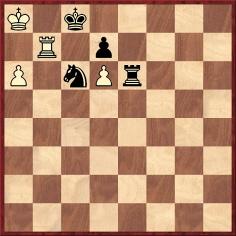Chess
Notes
|
| First column | << previous | Archives [70] | next >> | Current column |
6557. Chess authors
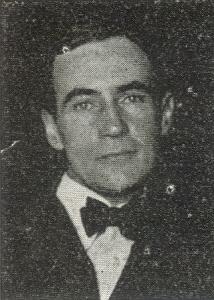

Almost every chess enthusiast will be familiar with the above authors, but who are they? The pictures come from a full-page advertisement for Bell books in the 1922 issue of Chess Pie.
6558. H.E. Bird and railways
On page 27 of The World’s Great Chess Games (New York, 1951) Reuben Fine wrote:
‘Incidentally, Bird was an outstanding accountant and became an authority on railway finance; in 1866 he published a book entitled An Analysis of Railways in the United Kingdom.’
And from page 27 (the entry on Bird) in The Encyclopaedia of Chess by Anne Sunnucks (London, 1970):
‘After the tournament [London, 1851] he had to abandon chess temporarily in order to concentrate on his profession, which was accountancy. During his lifetime he worked his way up from clerk to a partner in the firm and was the author of a book on railway finance, An Analysis of Railways in the United Kingdom, published in 1866.
Bird’s publications concerning the railways were referred to in an advertisement at the end of his book Chess Practice (London, 1882):
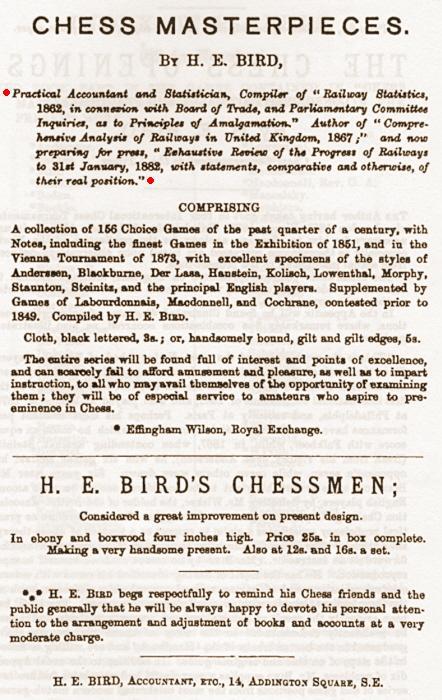
Page 284 of the July 1884 BCM reported that Bird ...
‘... is about to publish some Tables on the Railway Interests of England, which he believes to be of value and which, if he can keep the publication in his own hands, he hopes will be remunerative.’
In its obituary of the master the June 1908 BCM stated (page 251):
‘In his profession as an accountant Mr Bird ranked deservedly high, and as an authority on the details of railway accounts there was hardly a man in England his equal.’
Do readers own any of Bird’s publications regarding the railways?
6559. Hanging pawns (C.N.s 5725, 5731 & 5740)
The earliest use of the term ‘hängende Bauern’ found so far dates from 1905, but for the first instance in English our best offer at present is on page 84 of The Book of the London International Chess Congress 1922 by G. Maróczy (London, 1923), in the notes to the game between H.E. Atkins and C.G. Watson:

6560. Lasker in hospital
John Blackstone (Las Vegas, NV, USA) sends this item from the chess column of the Brooklyn Eagle, 9 January 1941, page 16:
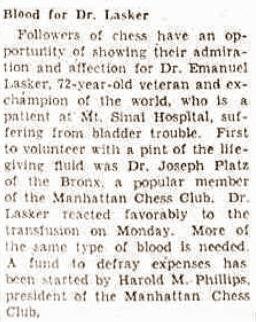
Two days later Lasker died. Joseph Platz gave a personal account of Lasker’s last days on page 40 of Chess Memoirs (Coraopolis, 1979).
6561. M. Murray and A.T. Leise
Mr Blackstone also forwards a feature from the Brooklyn Daily Eagle, 1 July 1926:
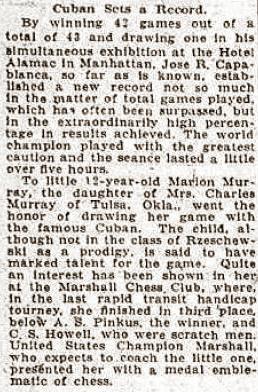
For a photograph of Miss Murray see C.N. 5991.
In its report on the Lake Hopatcong, 1926 tournament, the American Chess Bulletin related on pages 87-88 of the July-August issue:
‘Partnered by Marshall, on 13 July Miss Marian Murray played a consultation game against Dr B.M. Anderson Jr of New York and Charles Murray, the girl’s father. The game, a Queen’s Gambit Declined, was drawn in 41 moves. Marshall spoke well of his little ally’s play. ... A tussle on the chessboard between Max Rosen of the Manhattan Chess Club and Miss Murray resulted in favor of the famous violinist.’
In a list of visitors to Lake Hopatcong the same page of the Bulletin mentioned ‘Mr and Mrs Charles Murray and daughter, Marian, Tulsa, Okla.’.
Regarding the simultaneous display, the report in the New York Times of 28 June 1926 (Sports/radio section, page 14) said that the sole player to score even half a point against Capablanca was ‘Miss Marion V. Murray, who is 12 years of age’. This account of the exhibition was published on page 104 of the July-August 1926 American Chess Bulletin:
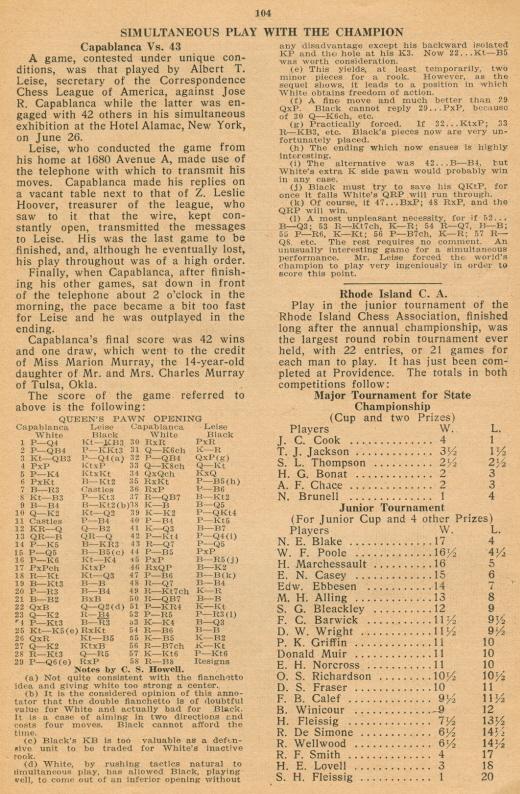
The Marion/Marian discrepancy needs to be cleared up, as does the question of her age at that time (12 or 14).
Capablanca’s game against Albert T. Leise is
available in databases, but the singular circumstances
of a simultaneous game played by telephone are worth
noting. Leise ‘had been a shut-in most of his life’
stated page 140 of the September-October 1928 American
Chess Bulletin, after his death on 30 September
that year, at the age of 28. Page 18 of the 1 October
1928 issue of the New York Times reported that
Leise ‘had been an invalid at his home since boyhood’
and described him as ‘one of the best known
chessplayers in the United States’. Leise was
certainly prominent in correspondence chess, and two
specimens of his play were annotated by him on pages
212-213 of the December 1921 American Chess
Bulletin. See also pages 43-47 of Correspondence
Chess in America by Bryce D. Avery (Jefferson,
2000).
6562. Tartakower blindfold
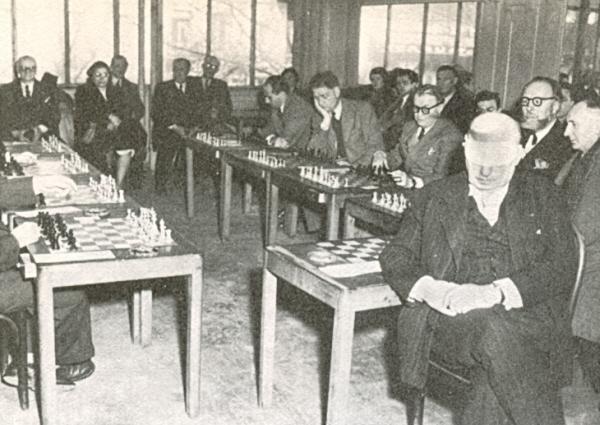
This photograph comes from page 92 of Objectif mat! by R. Bertolo and L. Risacher (Paris, 1978). Is any information available about the occasion?
6563. Staunton v Stanley match
Rod Edwards (Victoria, BC, Canada) writes:
‘The record of Howard Staunton’s matches given on pages 129-130 of your 1981 book World Chess Champions shows the result of his match with Charles Henry Stanley at the odds of pawn and two moves as +2 –3 =1, and the year is given as 1841. The Oxford Companion to Chess (first edition, page 324; second edition, page 389) concurs on the result and the year. Feenstra Kuiper’s Hundert Jahre Schachzweikämpfe (page 12), Golombek’s Encyclopedia (pages 307 and 456 of the hardback and paperback editions respectively) and Chess Results, 1747-1900 by Di Felice (page 3) all have the same result but give the year as 1839. Fiske’s New York, 1857 tournament book (page 406) states that the match was played not long before Stanley’s departure for the United States (which he says was in 1842), and that Stanley won “by a large majority”.
However, in the 1842 volume of the Chess Player’s Chronicle (page 368) Staunton wrote:
“Messrs St--n and S--y have played in all but 12 games, exclusive of drawn ones, at the odds of ‘the pawn and two moves’. Of these 12, Mr S--y won seven, and Mr St--n five.”
I wonder where the +2 –3 =1 result comes from originally, and how it can be reconciled with Staunton’s claim in the Chess Player’s Chronicle.
World Chess Champions indicates (page 130) that in cases where the final scores were not known the match results given “are those of surviving games”. Presumably, this does not apply to the Staunton-Stanley match, since I count eight game-scores in volume two of the Chess Player’s Chronicle (pages 117-118, 200, 211-212, 213, 226-228, 241-242, 293-294 and 324-325), amounting to +3 –4 =1 for Staunton. I wonder whether all these games were considered part of the formal match.’
The Staunton biography and results tables in World Chess Champions were by R.N. Coles. The only addition that we can offer at present is that an account of Stanley’s life on pages 364-367 of the August 1982 BCM (following research by Jeremy Gaige) stated that Staunton was defeated +2 –3 =1 and that the contest took place in December 1841.
6564. Prodigy in Paris
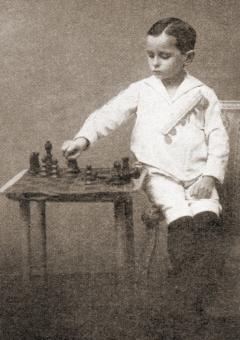
Samuel Reshevsky
Dominique Thimognier (Fondettes, France) draws our attention to his webpage on Reshevsky in Paris in 1920. In addition to reports and photographs, there are two game-scores absent from Samuel Reshevsky by Stephen W. Gordon (Jefferson, 1997), the opponents being Marc Herzfeld and Max de Gency.
6565. Stalemate as a win
From Robert John McCrary (Columbia, SC, USA):
‘In England for about 200 years stalemate was a win for the player who was stalemated. This paradoxical rule may have started with Arthur Saul’s The Famous Game of Chesse-play, published in London in 1614. In a section on page C3 called “The Diversity of Mates, and which are worthy of praise, or disspraise [sic]” he wrote, “The Stale, a dishonourable mate”. (Curiously, he also referred to “The Mate given with a Pawne, a disgraceful mate” and several other examples of “graceful or Honourable” mates or their opposite adjectives.) In Chapter XV, entitled “What a stale is, and how it is given”, Saul wrote: “... you shall understand that a stale is a lost game by him that giveth it, and no question to be made further thereof ...”, adding that players giving a stale “... purchase unto themselves such shame, which will not after be put away without much blushing”.
The rule that a player giving stalemate loses the game is repeated on page 91 of R. Lambe’s 1764 book The History of Chess: “... the King who is stale-mated wins the game”. On page 344 of the New York, 1857 tournament book Fiske quoted the Rou manuscript of 1734 as saying that this rule was observed only in England as of Rou’s day, and that elsewhere the position was drawn.
The rule was brought into the United States, as is shown by the first chess book by an American author: The Elements of Chess (Boston, 1805). Pages 13-14 said regarding stalemate: “... for the party thus crowding up the king is adjudged to have defeated himself, and his opponent is the winner.” Pages 19-20 presented advice on how to win by self-stalemate.
The rule disappeared during the early decades of the nineteenth century, as some subsequent English authors urged adoption of the stalemate-as-a-draw rule, although the controversy raged for a number of years before the change was accepted.
Page 38 of the second part of Phillip Stamma’s The Noble Game of Chess (London, 1745) had a composed position making use of the rule that a stalemated player wins:
Stamma gave “1 Rb8+ Nxb8 2 a7 ‘&tc.’.” English readers would have understood the “&tc.” as “White wins”. That is because the knight must move to avoid mate, but the resulting stalemate of White also wins for White.
Are there other examples of this paradoxical stalemate rule in compositions or games of the time?’
6566. Alfred de Musset
Han Bükülmez (Ecublens, Switzerland) asks for information about the original publication of Alfred de Musset’s famous mate-in-three composition.
It appeared on page 63 of La Régence, February 1849, and we are grateful to Jurgen Stigter (Amsterdam) for sending us a copy:
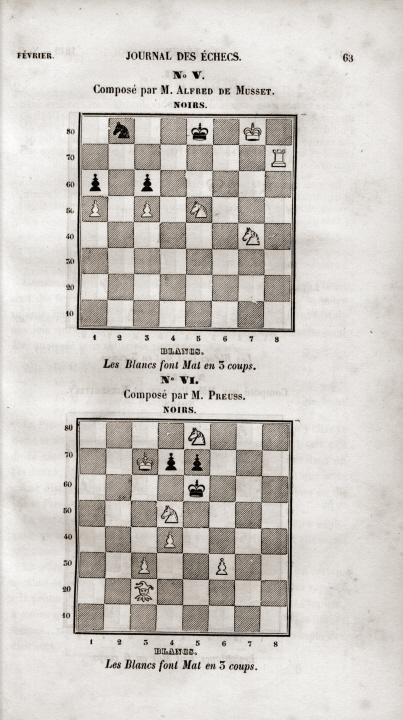
The solution was on page 79 of the March 1849 issue:

Nowadays the problem is usually given without the pawns. A curiosity is that the position was switched around on page 307 of Tal’s Winning Chess Combinations by M. Tal and V. Khenkin (New York, 1979):

As regards de Musset’s connection with chess, the following magazine articles come to mind:
- ‘Alfred de Musset als Schachspieler’ on pages 91-92 of Deutsches Wochenschach, 11 March 1906;
- ‘Le problème d’Alfred de Musset’ on pages 73-76 of La Stratégie, April 1920;
- ‘Alfred de Musset joueur d’échecs’ on pages 193-201 of issue seven of Les Cahiers de l’Echiquier Français (1926);
- ‘Alfredo de Musset, jugador de ajedrez’ on pages 331-332 of El Ajedrez Americano, November-December 1932.
6567. Different views (C.N. 6242)
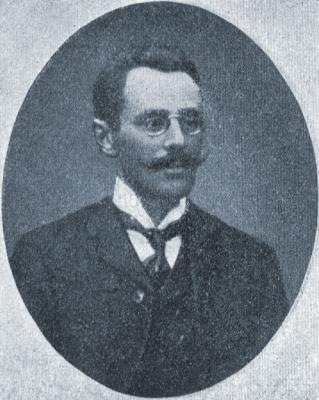
Dawid Janowsky
C.N. 6242 gave the following from Solitaire Chess
by I.A. Horowitz (New York, 1962) ...

... as well as this passage from page 17 of Why You Lose at Chess by F. Reinfeld (New York, 1956):
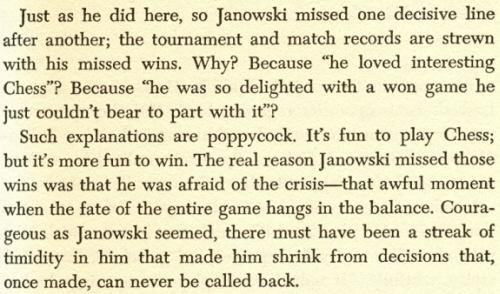
We now add a ‘once’ account from page 72 of a book co-authored by Horowitz and Reinfeld, How To Improve Your Chess (Kingswood, 1955):
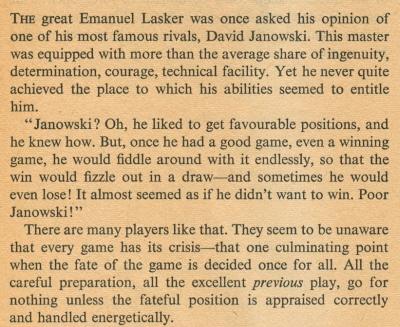
6568. Diego Morphy
Noting that Diego was the forename of several members of Paul Morphy’s family, Gilles David (Chatou, France) asks which of them edited this 1840 dictionary:
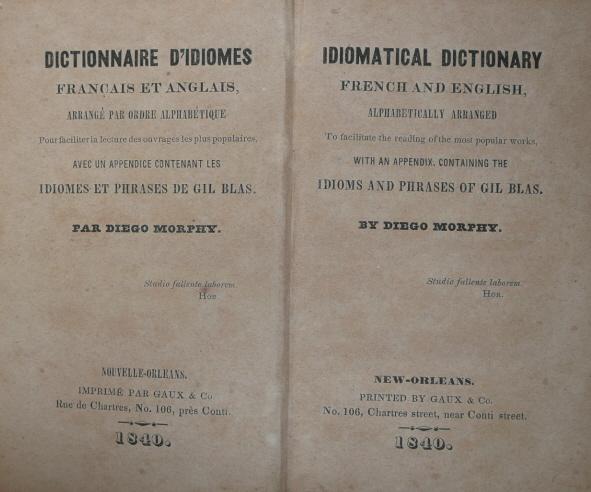
We note the following entry on pages 365-366 of Les écrits de langue française en Louisiane au XIXe siècle by Edward Larocque Tinker (Paris, 1932):
‘Diego Morphy, né à la Nouvelle-Orléans, fils de Diego Morphy, consul d’Espagne à la Nouvelle-Orléans et de sa femme Mollie Creagh; demi-frère du juge Alonzo Morphy, père de Paul Morphy qui, à son époque, était le champion du monde pour le jeu d’échecs. Est nommé, en octobre 1813, vice-consul d’Espagne et devient plus tard professeur de langues; épouse Eulalie Dubord, fille de Don Lorenzo Troisville Dubord et d’Eulalie Beaumont de Livaudais; enseigne jusqu’en 1852 et meurt de la fièvre jaune quelques années plus tard. Compose un dictionnaire à l’usage de ses élèves.’
He is marked in red on the family tree reproduced from page 112 of Morphy Gleanings by P.W. Sergeant (London, 1932):
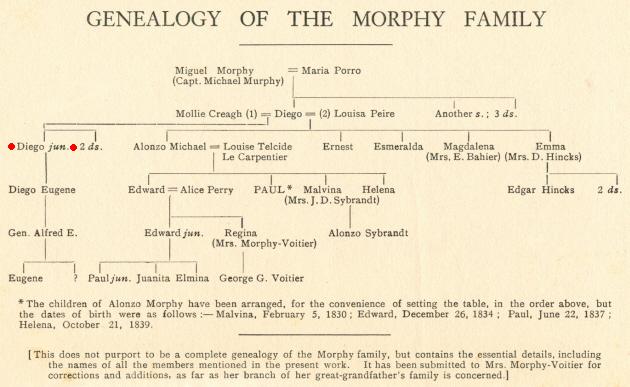
6569. A. Lilienthal
A selection of photographs of Lilienthal from our collection:
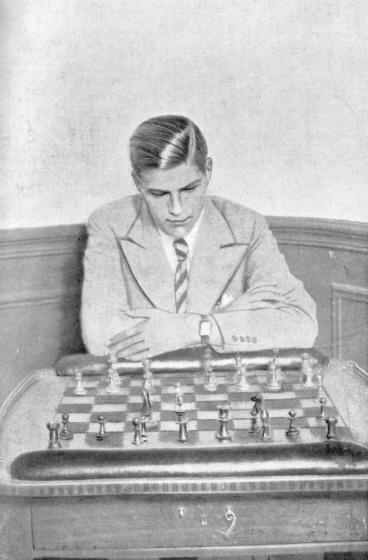
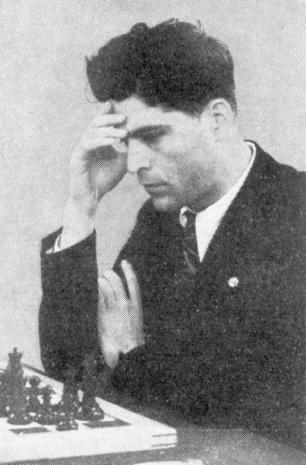
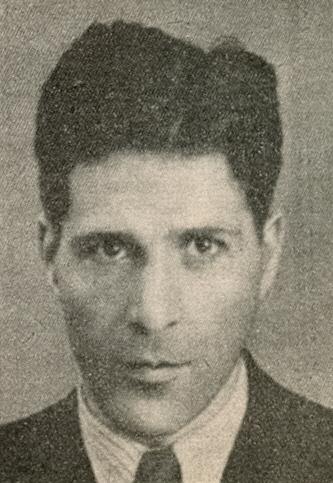
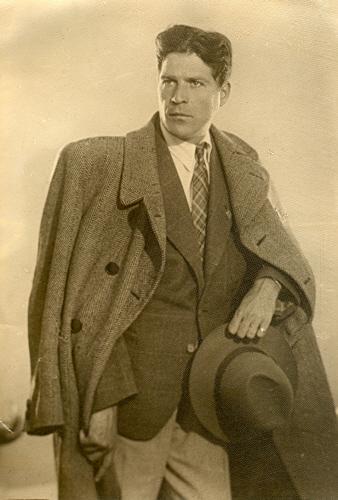
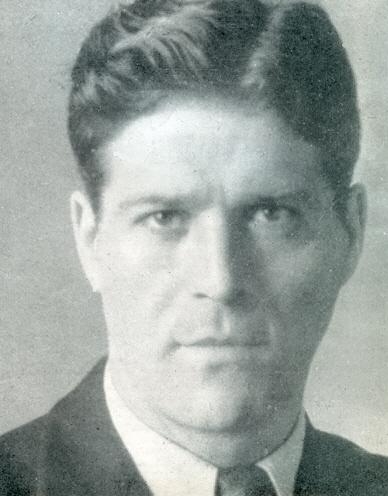

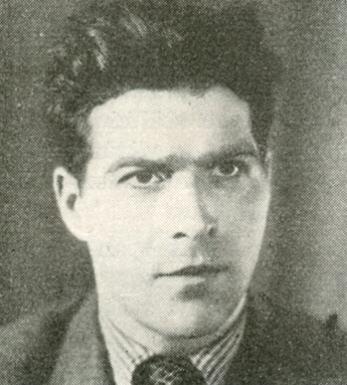
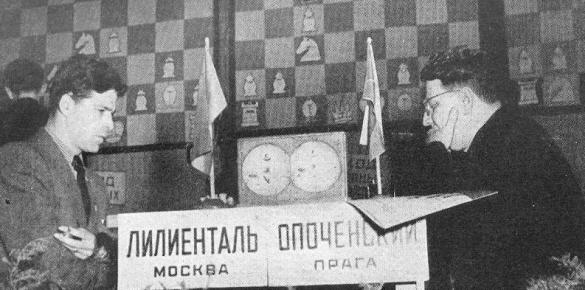
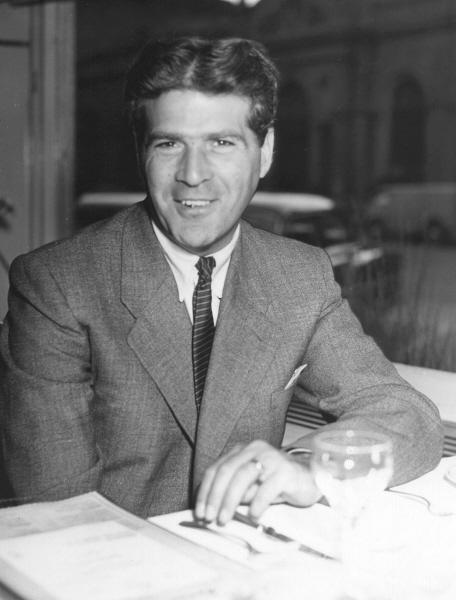
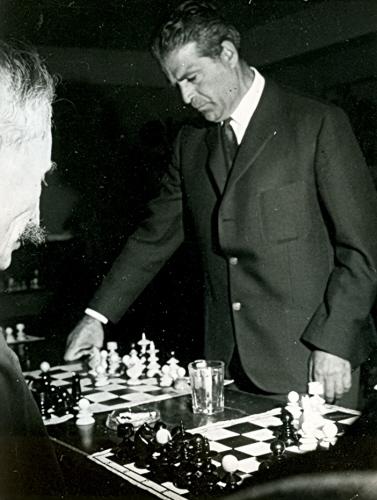
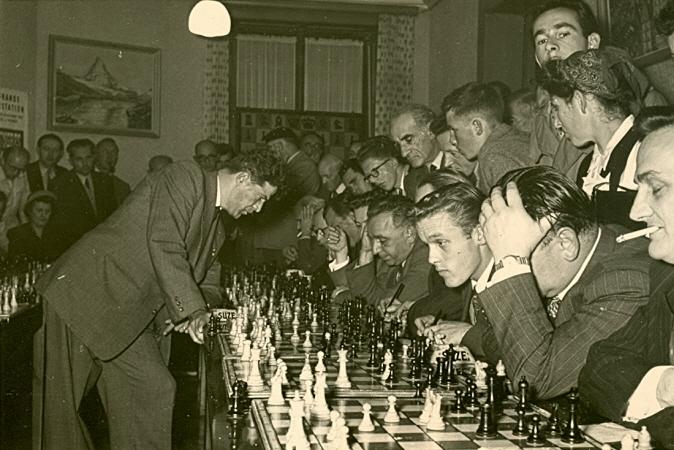
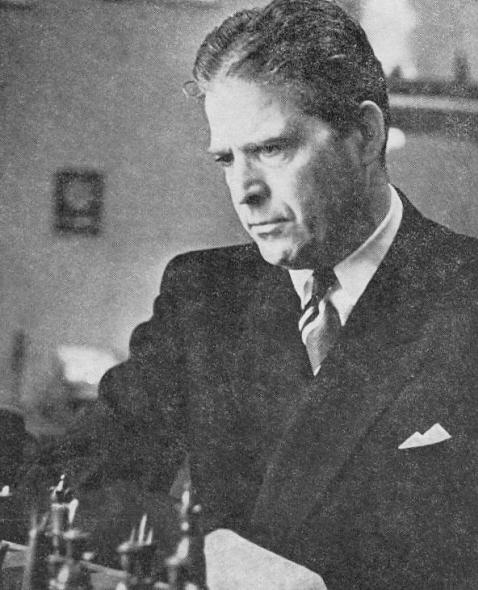
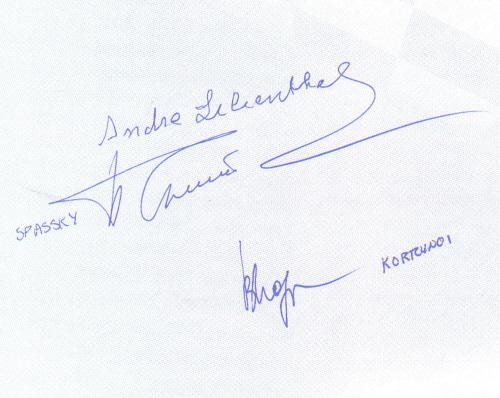
6570. Lilienthal v Alekhine
Lilienthal never defeated Alekhine in a tournament but was successful against him in blitz play. Since confusion sometimes arises over the matter, we reproduce the account provided by Lilienthal on page 24 of his autobiographical work Életem, a sakk (Budapest, 1985):
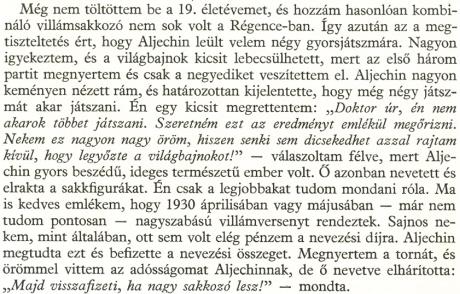
Below is the German translation, from pages 19-20 of Schach war mein Leben (Thun, Frankfurt/Main, 1988):
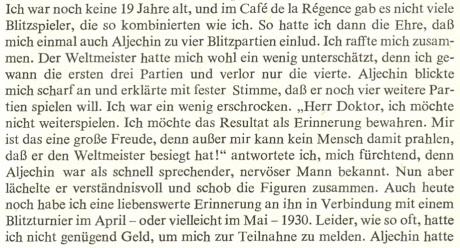

6571. Budapest
Gábor Gyuricza (Budapest) has sent us a copy of a bilingual booklet A budapesti sakkozás rövid története / A Short History of Chess in Budapest by László Jakobetz (Budapest, 2010). A particularly interesting chapter, contributed by our correspondent and by Iván Bottlik, is entitled ‘The disputed origin of the Budapest Defense’ (pages 37-48). With the co-authors’ permission we reproduce this photograph:
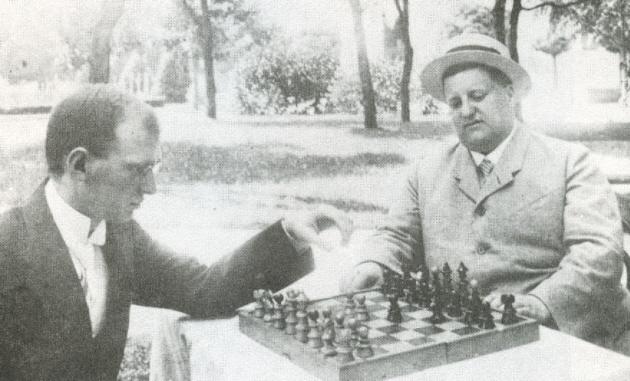
Gyula Breyer and István Abonyi
6572. Fischer book
Our compilation of books about Bobby Fischer (a list often misappropriated by other webpages) includes Bobby Fischer Un genio travieso by Frank Edwin Gormann (Buenos Aires, 1973), and it is only recently that we acquired a copy, thanks to Horacio Paletta (Buenos Aires).
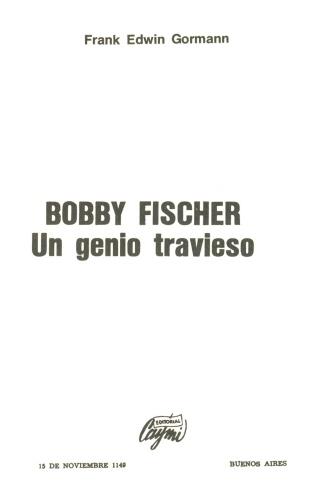
The 121-page work comprises a brief biographical section on Fischer and 15 annotated games. About F.E. Gormann we have no information.
6573. Pomar v Bernstein
We recall three photographs of Arturo Pomar in play against Ossip Bernstein at London, 1946:
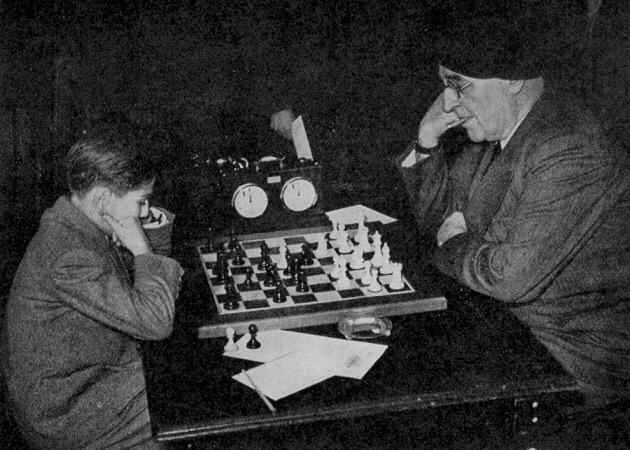
Sources: CHESS, February 1946, page 96; London, 1946 (Sutton Coldfield, 1946), page 10
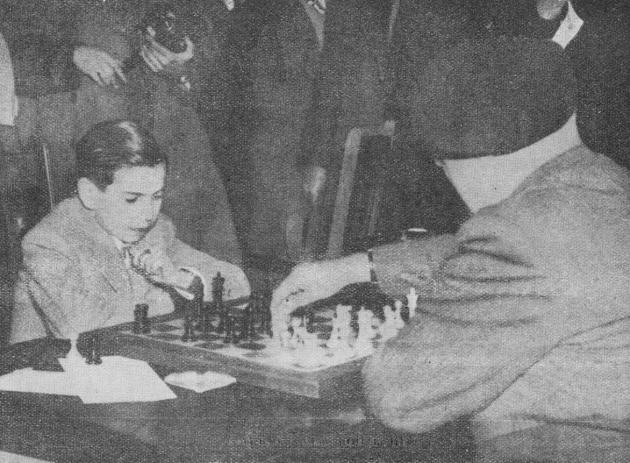
Source: La vida de Arturito Pomar by J.M. Fuentes and J. Ganzo (Madrid, 1946), opposite page 224
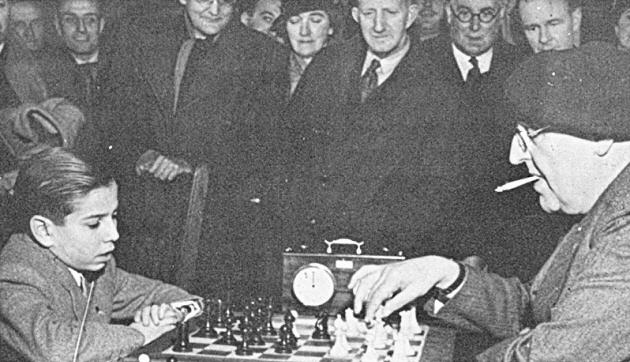
Source: The Encyclopedia of Chess by H. Golombek (London, 1977), page 28
However, in every source (including the above-mentioned tournament book and the volume on the event edited by E.G.R. Cordingley, as well as the The Times, the BCM and CHESS) where round-by-round reports and/or the game-score have been found it is stated that Pomar had the white pieces against Bernstein (the moves being 1 d4 d5 2 c4 e6 3 Nc3 Nf6 4 Bg5 Be7 5 e3 h6 6 Bh4 Ne4 7 Bxe7 Qxe7 8 cxd5 Nxc3 9 bxc3 exd5 10 Qb3 Qd6 11 Nf3 O-O 12 c4 dxc4 13 Bxc4 Nc6 14 O-O Na5 15 Qc3 Nxc4 16 Qxc4 Be6 17 Qb5 Bd5 18 Ne5 b6 19 Rfc1 c5 20 f4 cxd4 21 Rd1 Rfc8 22 Rxd4 Rc5 23 Qd3 Qe6 24 Rd1 Bxa2 25 Rd8+ Rxd8 26 Qxd8+ Kh7 27 Nd7 Qxe3+ 28 Kh1 Drawn).
When was the photographed game played?
6574. London war damage (C.N. 6551)
C.N. 6551 asked whether Norman Knight was correct to state that German bombs which fell on the British Museum Library in 1941 inflicted particularly severe damage on the chess section.
Michael Chambers (London) of the Humanities Reference Service of the British Library informs us:
‘Books on chess did indeed suffer heavy war damage as the shelfmark ranges occupied by books on the “useful arts” (including sport and games) were among those badly affected by the bombs which fell on the British Museum during World War II.
I did a sample search of the “General printed books pre-1975” subset of the British Library Integrated Catalogue for the term “chess” in the records for pre-1945 publications. Not all records for publications on the subject of chess will include this term, of course, but my search yielded over 850 results, more than 15% of which were evidently destroyed as a result of this enemy action.
Not all war-damaged items can be readily identified from the Integrated Catalogue, but the presence of “D-” before a shelfmark indicates a book destroyed in this way, and shelfmarks beginning “Mic.A” usually indicate war-damaged material replaced by microfilm copies from the Bodleian Library or elsewhere. The search results mentioned above included more than 70 instances of shelfmarks with a “D-” prefix and more than 60 instances of shelfmarks beginning “Mic.A”. Most of these items were published in the nineteenth and twentieth centuries (the latest destroyed item in my search results dated from 1939.)’
6575. Schlechter games
John Hilbert (Amherst, NY, USA) sends a pair of chess columns in which Carl Schlechter annotated two of his tournament games apparently now forgotten:
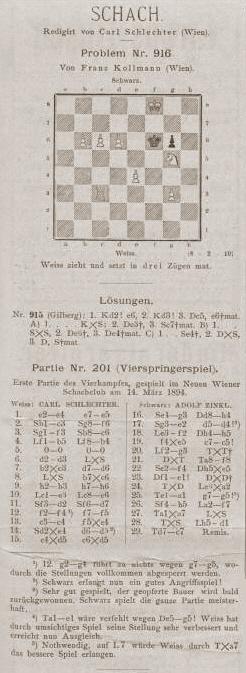
Source: Allgemeine Sport-Zeitung, 25 March 1894, page 279
Carl Schlechter – Adolf ZinklVienna, 14 March 1894
Four Knights’ Game
1 e4 e5 2 Nc3 Nf6 3 Nf3 Nc6 4 Bb5 Bb4 5 O-O O-O 6 d3 Bxc3 7 bxc3 d6 8 Bxc6 bxc6 9 h3 h6 10 Be3 Be6 11 Nd2 Nd7 12 f4 f5 13 c4 fxe4 14 Nxe4 d5 15 cxd5 cxd5 16 Ng3 Qh4 17 Ne2 d4 18 Bf2 Qh5 19 fxe5 c5 20 Bg3 Rxf1+ 21 Qxf1 Rf8
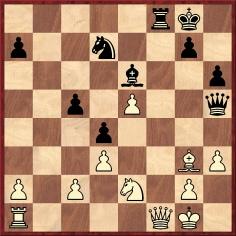
22 Nf4 Qxe5 23 Qe1 Qxe1+ 24 Rxe1 Bxa2 25 Ra1 g5 26 Nh5 Bf7 27 Rxa7 Bxh5 28 Rxd7 Bd1 29 Rc7 Drawn.

Source: Allgemeine Sport-Zeitung, 13 December 1896, page 1391
Carl Schlechter – Jacques Mieses
Vienna, 6 November 1896
King’s Gambit Declined
1 e4 e5 2 f4 Bc5 3 Nf3 d6 4 Nc3 Nc6 5 Bb5 Nf6 6 d3 Ng4 7 Qe2 Bf2+ 8 Kd1 Bb6 9 Rf1 exf4 10 Bxf4 O-O 11 Bxc6 bxc6 12 h3 Nf6 13 Bg5 Ba5 14 Nd4 Bxc3 15 Bxf6 gxf6 16 bxc3 c5 17 Nf5 Bxf5 18 Rxf5 Kh8 19 Qf3 Rg8 20 g4 Rg6
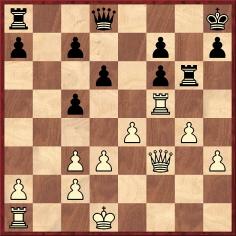
21 Rb1 Qe7 22 c4 Qd8 23 Ke2 Rb8 24 Rb3 a5 25 h4 a4 26 Rxb8 Qxb8 27 h5 Rg8 28 Rxf6 Qb2 29 Rxf7 Qxc2+ 30 Kf1 Qb1+ 31 Kg2 Qxa2+ 32 Kh3 Qa1
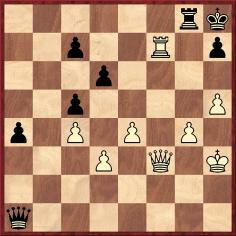
33 Re7 Resigns.
6576. Hilversum, 1947
From 101 partijen van het Europees schaaktournooi te Hilversum in 1947 by M. Euwe and L.G. Eggink:
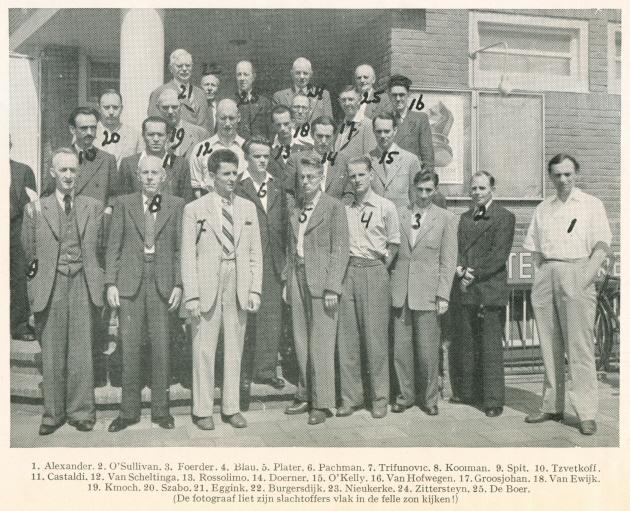
6577. E.E. Colman
Olimpiu G. Urcan (Singapore) writes:
Frank James Marshall – Eugene Ernest Colman‘Pages 71-75 of my book Surviving Changi. E.E. Colman: A Chess Biography provided an account of the match at the City of London Chess Club between F.J. Marshall and Colman on 27-29 April 1911 (won by Marshall +2 –1 =0). It was mentioned that only one of the games, Colman’s win, had been found, but I have now traced further information about the match, as well as the moves of the other two games.
The Straits Times of 31 May 1911, page 2, provided an extensive report dated 1 May 1911. All three games were included, and an eye-witness stated:
“While there [in Tunbridge Wells], he [Colman] arranged with the American champion, Mr F.J. Marshall, who had come over from his victories at San Sebastián to lead his countrymen in the cable match, to play a match of three games in London for a small stake. This match took place at the City of London Chess Club last week. The time-limit was 15 moves an hour, and Mr Colman lost the odd game. It was unfortunate that the deciding game had to be abandoned to the American at an interesting point through an oversight by Mr Colman, who was pressed for time. The games proved full of vigorous chess on both sides. I was fortunate to be present on Friday night when your champion beat the great American master, who was evidently chagrined at his loss.”
Colman’s victory over Marshall (in which he had White in a Queen’s Gambit Declined) was given on page 253 of my book, culled from the chess column of The Globe and Traveller of 6 May 1911 (page 10). Below are the other two games, and they show that Bruce Hayden was wrong when he stated that during this match Colman “repelled the famous Marshall Counter-Attack in the Ruy López, many years before its inventor was to play it against Capablanca in the New York tournament of 1918”. (See Hayden’s article in Chess Review, May 1953, pages 139-140, and his obituary of Colman in the October 1964 BCM, pages 298-300.)
The score of the first match-game has been corrected by me, starting with move 39. I reconstructed the game from that point, being convinced that there were typos in the score. Other errors were found: “23 Re7” instead of the obvious 23 Rd7, and “47 a7” and “48 Ra1” whereas it is evident that the moves 47 Ra1 and 48 a7 occurred in the game.’
First match-game, London, 27 April 1911
Two Knights’ Defence
1 e4 e5 2 d4 exd4 3 Nf3 Nc6 4 Bc4 Nf6 5 O-O Nxe4 6 Re1 d5 7 Bxd5 Qxd5 8 Nc3 Qd8 9 Rxe4+ Be7 10 Nxd4 f5 11 Rf4 O-O 12 Be3 Bd6 13 Nxc6 bxc6 14 Rd4 c5 15 Rd2 Bb7 16 Bf4 Qh4 17 Bxd6 cxd6 18 Rxd6 f4 19 f3 Rae8 20 Qf1 Rf5 21 Qf2 Qg5 22 Rad1 Rfe5 23 Rd7 Bc6 24 Rxa7 Re3 25 h4 Qh5 26 Rf1 R8e6 27 Rc7
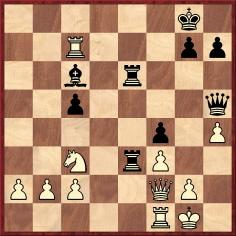
27...Bxf3 28 Rc8+ Kf7 29 Qd2 Qg4 30 Nd5 Bxd5 31 Qxd5 Qxh4 32 Qf5+ Rf6 33 Rc7+ Re7 34 Qd5+ Rfe6 35 Qxc5 h6 36 Rc6 g6 37 a4 Kf6 38 Rxe6+ Rxe6 39 Qd4+ Kf5 40 Qd3+ Kf6 41 Qd8+ Re7 42 Qd6+ Kf5 43 Qd3+ Kg5 44 a5 Qg3 45 Qxg3+ fxg3 46 a6 h5 47 Ra1 Re8 48 a7 Black resigned.
Source: The Straits Times, 31 May 1911, page 2.
Frank James Marshall – Eugene Ernest ColmanThird match-game, London, 29 April 1911
Queen’s Gambit Declined
1 d4 d5 2 c4 e6 3 Nc3 c6 4 e3 Nd7 5 Bd3 Bd6 6 f4 f5 7 Nf3 Ngf6 8 O-O Ne4 9 Bd2 Nxd2 10 Qxd2 Nf6 11 Rac1 O-O 12 Qc2 Ne4 13 g4 fxg4 14 cxd5 exd5 15 Nxe4 dxe4 16 Bc4+ Kh8 17 Ng5 Qc7 18 Qb3 h6 19 Nxe4 Bf5 20 Nxd6 Qxd6 21 Bd3 Rae8 22 Bxf5 Rxf5 23 Qd3 Qe6 24 Rce1 g5 25 fxg5 Rxg5 26 Qc3 Kg8 27 e4 g3 28 hxg3 Qh3 29 Rf3 Rh5 30 Kf2 Rf8 31 Qb3+ Black resigned.
Source: The Straits Times, 31 May 1911, page 2.
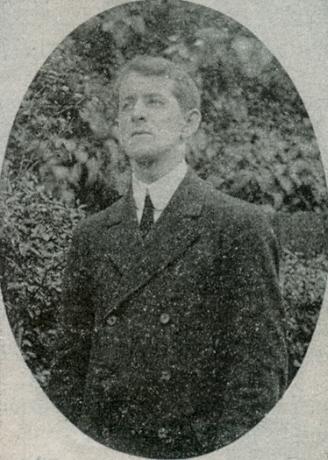
Eugene Ernest Colman (Chess Review, May 1953, page 139)
6578. Wyllie/Wylie (C.N. 6524)
From David Archibald, the Secretary of the Edinburgh Chess Club:
‘Our records list “David Wylie” as being one of the 1822 founding members and a subscriber until the 1830s. There is no record of any “Wyllie” during this period.’
6579. Wheat and chaff
A famous quip attributed to Adlai Stevenson (1900-65):
‘An editor is one who separates the wheat from the chaff and prints the chaff.’
Quotations books also have this remark by Elbert Hubbard (1856-1915):
‘Editor: a person employed by a newspaper, whose business it is to separate the wheat from the chaff, and to see that the chaff is printed.’
We note, though, an observation on page 3 of the Westminster Papers, May 1869, in a demolition of The Book of Chess by George H. Selkirk (London, 1868):
‘His compilations are singularly crude and valueless; indeed they seem to have been conducted on the principle of carefully sifting the wheat from the chaff and retaining the chaff.’
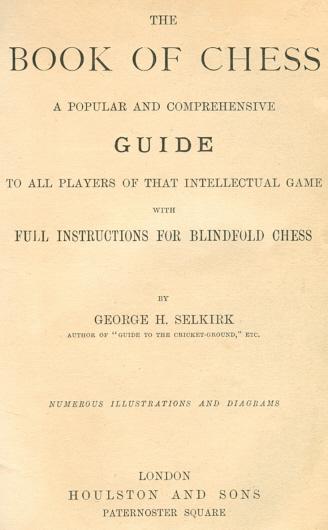
6580. The Löwenthal Variation
Carl Boor (Columbus, OH, USA) asks why 1 e4 c5 2 Nf3 Nc6 3 d4 cxd4 4 Nxd4 e5 5 Nb5 a6 is often called the Löwenthal Variation and whether Johann Löwenthal ever played it.
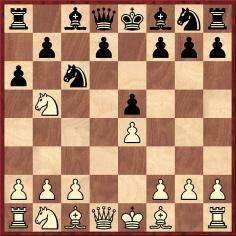
As regards terminology, the chapter on the ‘Lowenthal Variation’ on pages 140-144 of Beating the Sicilian 2 by John Nunn (London, 1990) began:
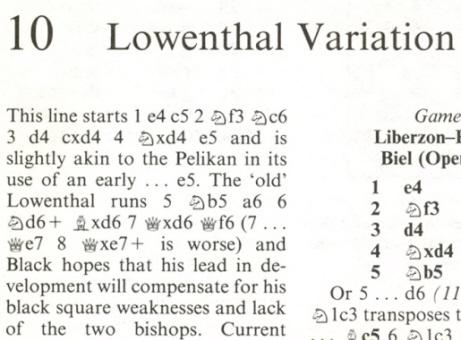
Page 202 of the tenth edition of Modern Chess Openings (Evans/Korn, 1965) stated that 4...e5 ‘was originated in the game Macdonnell-Labourdonnais in 1839 and later enlarged upon by Löwenthal’. The year 1839 was naturally wrong (Alexander McDonnell having died in 1835), and on page 174 of the eleventh edition (Korn, 1972) the comment on 4...e5 became:
‘This thematic move was originated in a game MacDonnell-Labourdonnais in 1934 and later enlarged upon by Löwenthal.’
The same sentence appeared on page 208 of the twelfth edition (Korn, 1982), except that the correct date, 1834, was given at last.
An historical note regarding 4...e5 was provided on page 355 of La defensa siciliana by Carlos A. Palacio (Havana, 1973), in a chapter headed ‘Variante Lowental [sic] – Labourdonnais’:
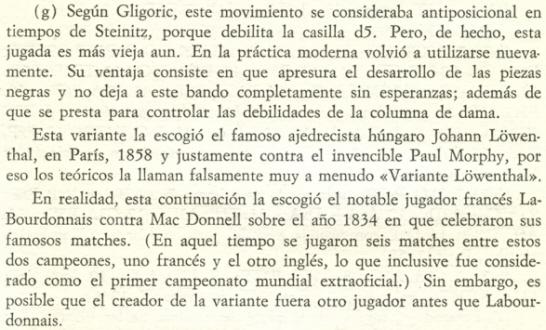
Löwenthal’s match against Morphy in 1858 was played in London, not Paris. The Sicilian Defence occurred twice:
- Sixth match-game (White: Morphy) 1 e4 c5 2 d4 cxd4 3 Nf3 Nc6 4 Nxd4 e5 5 Nxc6 bxc6;
- Eleventh match-game (White: Löwenthal) 1 e4 c5 2 Nf3 e6 3 d4 cxd4 4 Nxd4 Nc6 5 Nb5 a6.
Both games were annotated by Löwenthal in his book Morphy’s Games of Chess (London, 1860), but his observations contain nothing of relevance to the ‘Löwenthal Variation’ appellation.
We recall no games by Löwenthal which began 1 e4 c5 2 Nf3 Nc6 3 d4 cxd4 4 Nxd4 e5 5 Nb5 a6, but in 1865 the Chess Player’s Magazine (of which he was the editor) had an article in six instalments, ‘The Sicilian Opening’. The fifth part (pages 162-164) discussed a line which began 1 e4 c5 2 Nf3 Nc6 3 d4 cxd4 (‘best’) 4 Nxd4 e5 5 Nf3 (‘best’) Nf6, and page 164 contained this comment:
‘In the above variation we may observe that White might also have played 5 Nb5. But that move is far less potent when Black has advanced his king’s pawn two squares than when he has only moved it one step.’
Then the article turned to the ‘second defence’ (2...e6), the ‘first defence’ having been 2...Nc6. The following moves were given: 1 e4 c5 2 Nf3 e6 3 d4 cxd4 4 Nxd4 Nc6 5 Nb5.
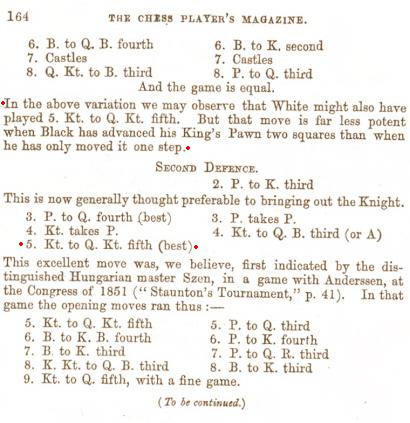
When the article was resumed on page 193 of the following issue, Löwenthal was named (with an incorrect reference to the ‘ninth game’, instead of eleventh, of his match against Morphy):

The awkward presentation, in conjunction with different positions in which 5 Nb5 could be played, offered scope for complications and misunderstandings about the use of Löwenthal’s name, but the whole matter seems murky. Wanted: early uses of the term ‘Löwenthal Variation’ with reference to a) 4...e5 only and b) 4...e5 5 Nb5 a6.

Source: BCM, August 1926, page 346.

We can cite only one nineteenth-century game which reached the diagrammed position: the eleventh match-game between de Rivière and Journoud (Paris, 1859). Staunton annotated it on page 19 of the 7 January 1860 Illustrated London News, and we are grateful to Rod Edwards (Victoria, BC, Canada) for supplying a copy:
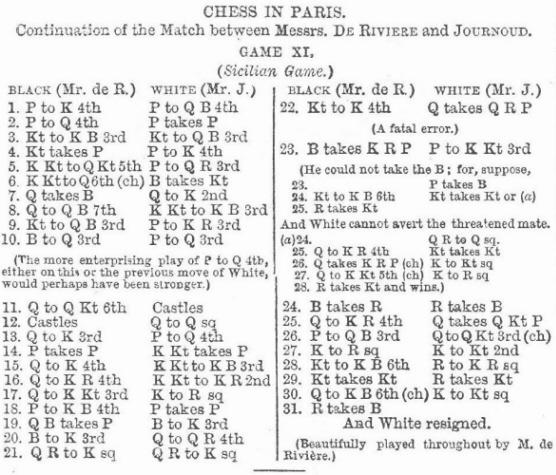
6581. Judicious violation (C.N. 4297)
C.N. 4297 noted that the entry on Löwenthal on page 122 of the Dictionary of Modern Chess by Byrne J. Horton (New York, 1959) stated:
‘One of Löwenthal’s famous quotations is: “The judicious violation of general principles marks the master-mind”.’
The exact source of the observation was requested, and we now see the following (a game between Morphy and Julien) on page 415 of Morphy’s Games of Chess by J. Löwenthal (London, 1860):
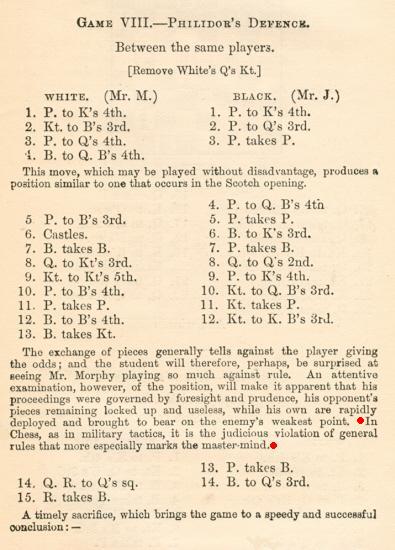
The wording is thus slightly different: ‘In Chess, as in military tactics, it is the judicious violation of general rules that more especially marks the master-mind”.’
6582. Morphy v the Duke and Count
Our feature article Morphy v the Duke and Count quoted from pages 158 and 160 of Paul Morphy The Pride and Sorrow of Chess by D. Lawson (New York, 1976):
‘The Duke of Brunswick, with whom Morphy first dined on 19 September, was a confirmed chessplayer, hardly to be seen otherwise than at chess. Edge says they were frequent visitors to the Duke’s box at the Italian Opera and even there the Duke played chess. On their first visit in October they played chess throughout the entire performance of Norma. Edge mentions Morphy’s discomfiture when he was the Duke’s guest, since he was obliged to sit with his back to the stage, while facing the Duke and Count Isouard consulting against him.
On 2 November they heard The Barber of Seville, during which Morphy played his most famous game, the Duke again consulting with Count Isouard.’
Fabrizio Zavatarelli (Milan, Italy) notes that the
information in the latter paragraph does not match the
announcements of opera performances published in the
Parisian newspaper La Presse.
Page 3 of the (Sunday) 31 October 1858 edition announced two operas being performed on 1 November:
- La Magicienne at the Opéra;
- Les Noces de Figaro at the Théâtre Lyrique.
Page 3 of the 1-2 November 1858 issue of La Presse stated that the following would be performed on 3 November:
- Le Comte Ory – la Sylphide at the Opéra;
- La Perle du Brésil at the Théâtre Lyrique.
Page 3 of La Presse, 3 November 1858 announced these performances on 4 November:
- Il Barbiere di Siviglia at the Italiens;
- Les Noces de Figaro at the Théâtre Lyrique.
The Opéra was not listed as a venue in the 3 November newspaper.
Does a solid contemporary source exist to support the
date of the Morphy game put forward by Lawson? The
listings in La Presse suggest that there were no
theatrical performances at all on 2 November, a day of
prayer in the Roman Catholic Church (Le jour des
Morts/All Souls’ Day).
6583. Capablanca’s origins (C.N. 3500)
From Christian Sánchez (Rosario, Argentina):
‘C.N. 3500 presented a summary of what is known about Capablanca’s origins, and I note that page 156 of the April 1922 issue of “Our Folder” had similar information, given by Capablanca himself:
“Jose Raoul Capablanca was born in Havana, Cuba, November 19th, 1888, and was educated at Columbia University, New York City. He married in Havana, December 29th, 1921, Senorita Gloria Simoni, a member of one of the oldest Cuban families, with an estate at Camaguey. His father, Jose Capablanca, was born in 1863, in Bayamos, Cuba, and is an officer in the Cuban Army. In 1884 he married Matilda Maria Graupera, who was born in Matanzas City, Cuba.
Of his four grandparents, three were born in Spain and one in Cuba.
Mr Capablanca’s early ancestors were Italians, the name was originally Cappa Bianca, meaning White Cloak. They settled in Spain during the reign of Charles IV, and the name became Capablanca.”
The last paragraph indicates that the family was well aware of its Italian origins.
Page 157 has a photograph of Capablanca and his bust, modelled by the famous sculptor Gleb Derujinsky. The article is on Capablanca’s simultaneous display in Philadelphia on 25 February 1922 and includes several endings unknown to me. The only game which I found in databases is wrong: Capablanca v John Welsh Young. The periodical has the correct finish.’
Mr Sánchez has provided the pages in question:
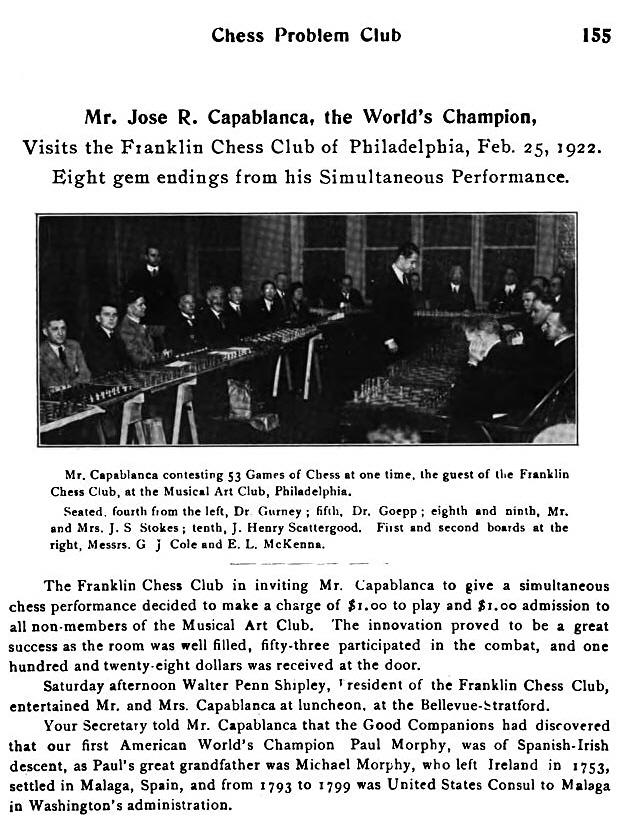
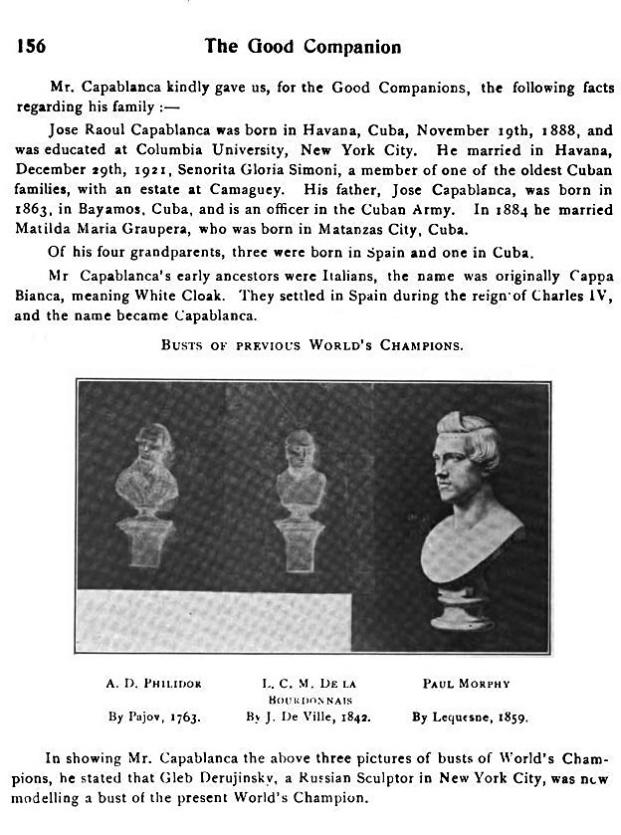
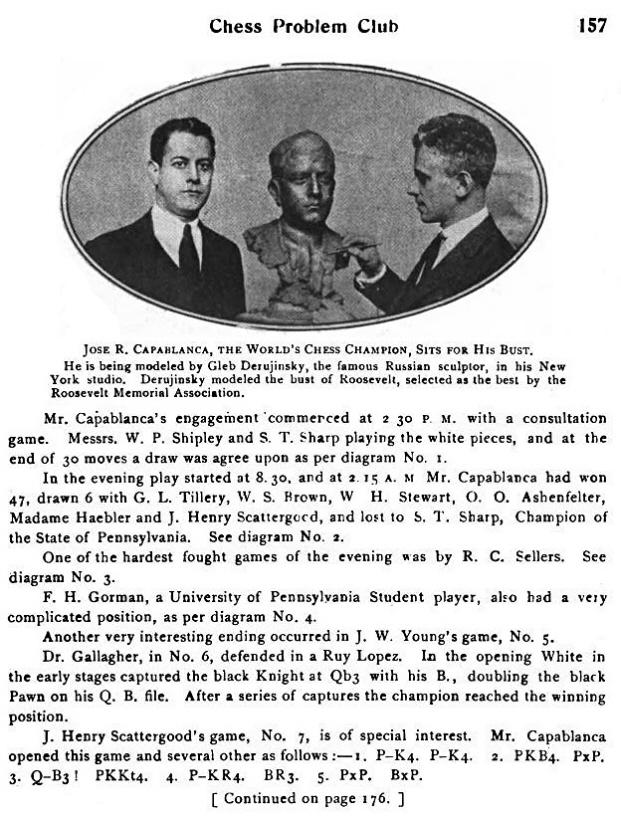
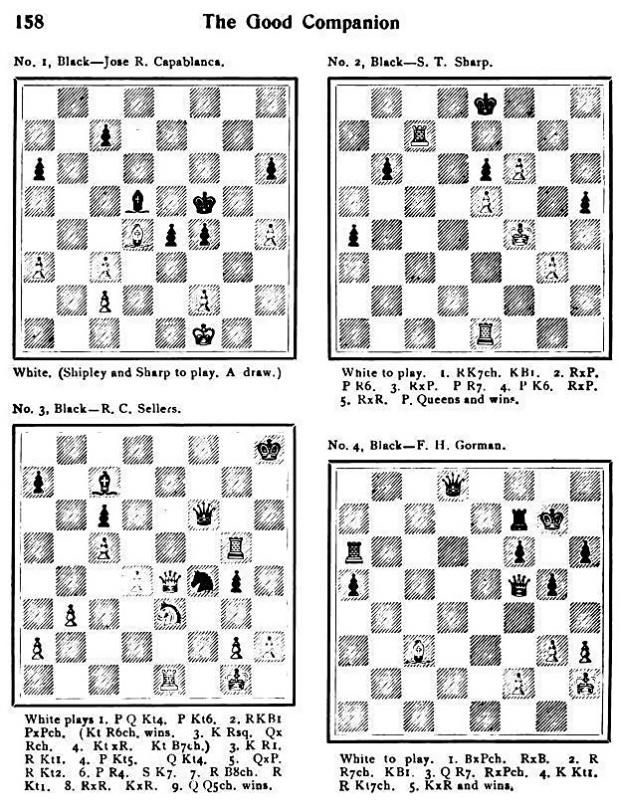
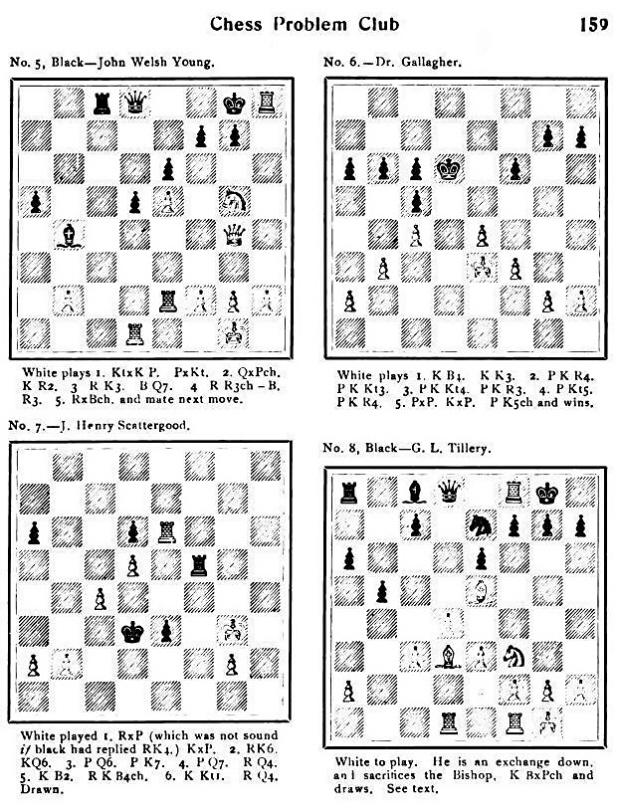
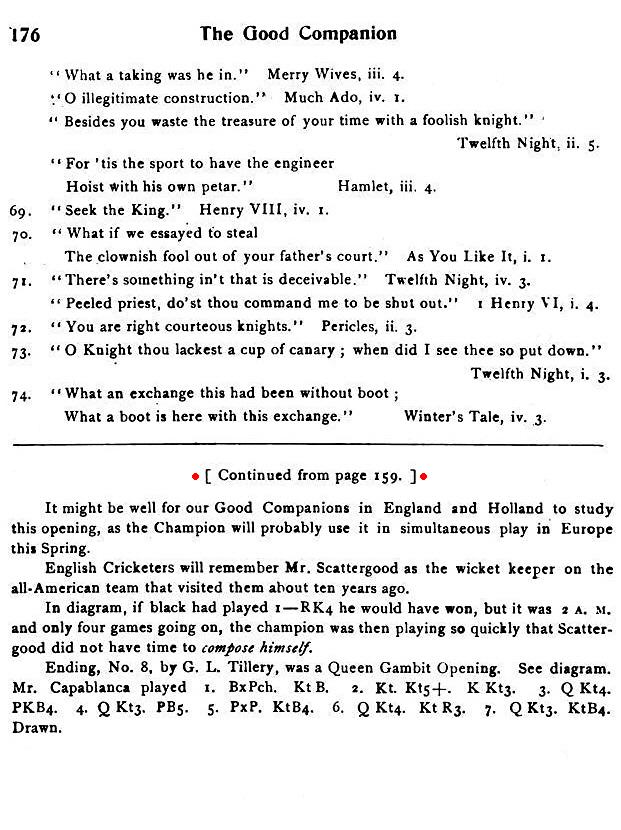
6584. Pomar v Bernstein (C.N. 6573)
Leonard Barden (London) wonders whether the three Pomar v Bernstein photographs in C.N. 6573 were taken shortly before the London, 1946 tournament, to promote media interest:
‘In the third photograph the spectator standing one from the right is G.H. White, the leader of the consortium including G. Wood and B.H. Wood which bought out Edith Price from the Gambit Chess Rooms. The man clutching the chair with only the lower half of his face visible looks like Walter Veitch, who was a regular player at the Gambit.’
For purposes of comparison, below is a photograph of the first day’s play in the London tournament, published on page 6 of The Times, 15 January 1946:
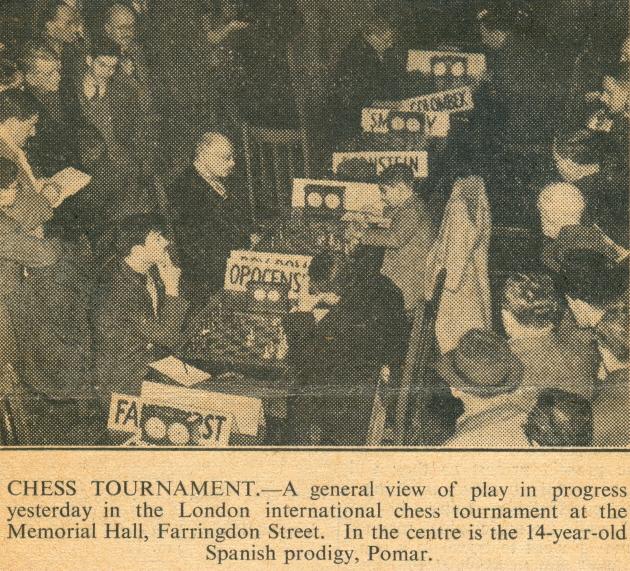
The newspaper’s report began:
‘An unfortunate hitch has occurred in the London chess tournament. The long expected Russian players have failed to turn up, and the players against whom they were paired awaited them in vain.’
The name-cards show that Smyslov was one of those expected and that he was scheduled to play Bernstein.
6585. Hype
Which chess book contains the most hype? One promising contender (at least from the pre-Cardoza era) is Fred Reinfeld’s Beginner’s Guide to Winning Chess, which was first published in 1964, the year he died. Here is the back-cover of the 1994/2006 paperback edition from Foulsham (which used the spelling Beginners’):
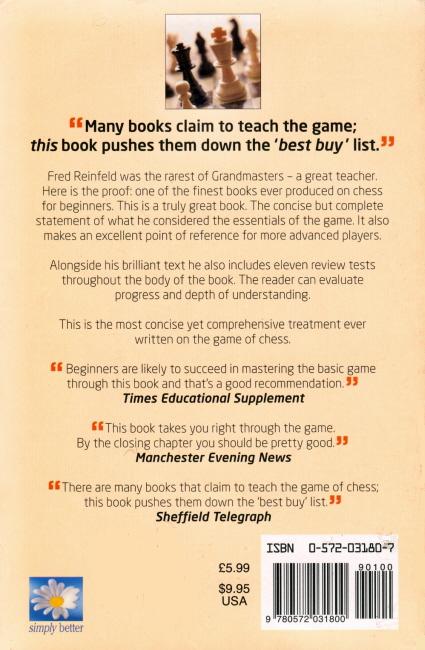
There is plenty more inside concerning ‘the rarest of Grandmasters’. Page 6 (‘About the Author’) starts:
‘Fred Reinfeld was, as Dr M.W. Sullivan states in his introduction to Beginners’ Guide to Winning Chess, a brilliant chess player and “the leading writer on chess in the entire history of the game”. This is indeed saying a great deal, since chess has been played for more than a thousand years, but the overwhelming evidence is that the Sullivan statement is actually true!’
After a page in similar vein, Dr Sullivan takes over the loud-hailer for his introduction (pages 7-8). It begins:
‘Ours is no age for a universal genius, but Fred Reinfeld offers us a close approximation of the ideal. The quality and quantity of his books made him not only the finest chess author of his day, but also the leading writer on chess in the entire history of the game.
Of course, Fred Reinfeld was a brilliant chess player ... as great a writer as he was chess player.’
Much more could be quoted, but we merely observe that it was not one-way traffic. Dr Sullivan was the author of A Programmed Introduction to the Game of Chess, and it included a full-page encomium by Reinfeld which worked itself up to the following finale:
‘... this is the most revolutionary book ever written on chess – a work that is destined to have a profound influence on all worthwhile chess books of the future.’
6586. Birdie Reeve (C.N. 6326)
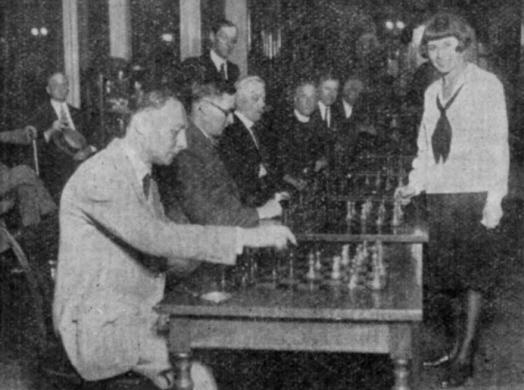
The difficult hunt for chess-related information about Birdie Reeve continues, but we have now acquired two further (non-chess) photographs of her:
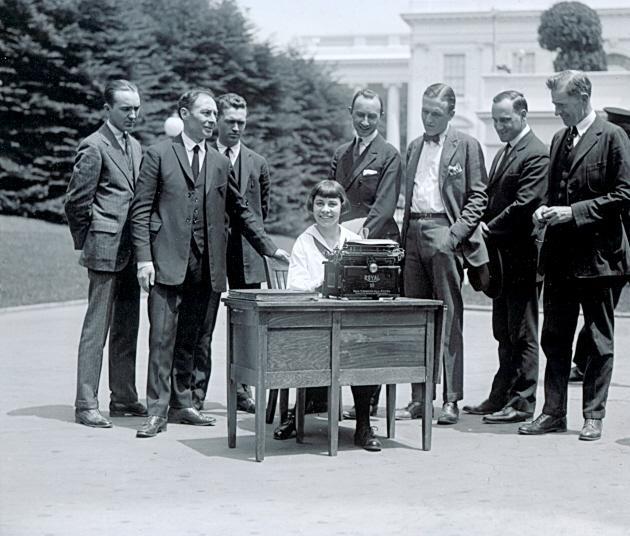
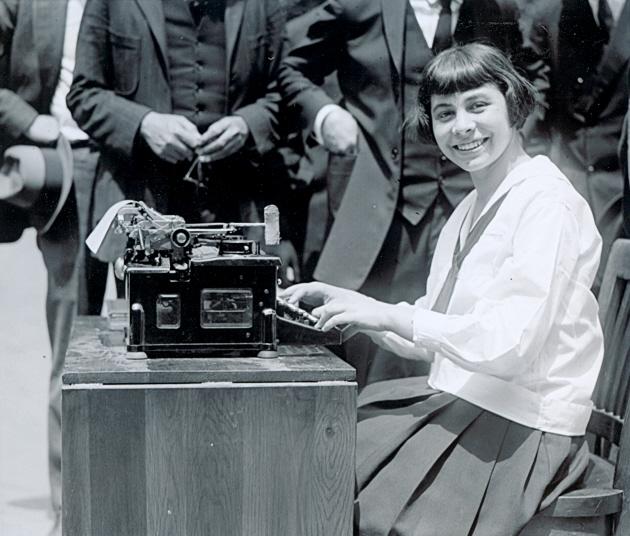
6587. An alleged Alekhine quote
Robert Desjarlais (Bronxville, NY, USA) asks for information about a quote often ascribed to Alekhine, although without any reliable source:
‘During a chess competition a chess master should be a combination of a beast of prey and a monk.’
There are textual variants, but the above wording had a page to itself (88) in Bruce Pandolfini’s Treasure Chess (New York, 2007). Of itself, that naturally proves nothing (C.N. 5280 shows why), and we do not recall seeing the sentiments expressed in Alekhine’s writings.
There is, though, the following ‘once’ version on page 8 of Blunders and Brilliancies by Ian Mullen and Moe Moss (Oxford, 1990):
‘Alekhine was once quoted as saying that the successful tournament player must combine the chief characteristics of a research scientist, an ascetic monk and a beast of prey.’
At Google Books we found this sentence about Alekhine in an article ‘Chess Masters in Action’ by C.H.O’D. Alexander published in the Irish Digest, 1959:
‘Playing him, one gets a strong sense of someone dedicated to the game – a mixture of monk and scientist.’ [In fact, Alexander was writing about Botvinnik. See C.N. 6596.]
Only a snippet of Alexander’s text is available on-line, and we shall be grateful to any reader who can supply the full article – and especially since it seems also to contain information of relevance to the Alexander v Botvinnik c4/c5 matter (C.N.s 4292 and 6185).
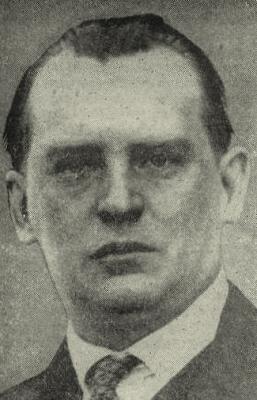
Alexander Alekhine
6588. Bogoljubow’s correspondence chess
Pages 16-23 of volume three of Klassische Schachpartien by E. Bogoljubow (Berlin and Leipzig, 1928) had a section on correspondence chess. He reported that between October 1920 and August 1921 he played 25 games against Swedish players and clubs, scoring +19 –1 =5. Below is the first of the five games (one of two between the same parties) which Bogoljubow annotated. His punctuation is provided here for general guidance:
Eskilstuna Club (W. Lundmark) – Efim BogoljubowCorrespondence, 1920-21
Sicilian Defence
1 e4 c5 2 Bc4 Nc6 3 Nf3 e6 4 Qe2 Be7 5 Nc3 a6 6 a4 Nb4 7 d3 d5 8 Bb3 Nf6 9 Bd2 dxe4 10 Nxe4 Nbd5 11 Ne5! O-O 12 O-O Qc7 13 f4 b6 14 Rae1 Bb7 15 c3 Rad8 16 Ng5! h6

17 Rf3!! b5 18 Rh3 c4! 19 dxc4 Qb6+ 20 Kh1 bxc4 21 Bxc4 Qxb2 22 Ngxf7 Rxf7 23 Nxf7 Kxf7 24 Qxe6+ Kf8 25 Rd3! Bc8 26 Qe5! Qb7 27 f5 Ng4! 28 Qg3 h5!! 29 h3 Ngf6 30 Qg6 Qc7 Drawn.
Bogoljubow’s concluding comment was:
‘One of the most difficult correspondence games that I have ever played.’
This portrait was the frontispiece to volume one of Klassische Schachpartien (Berlin and Leipzig, 1926):
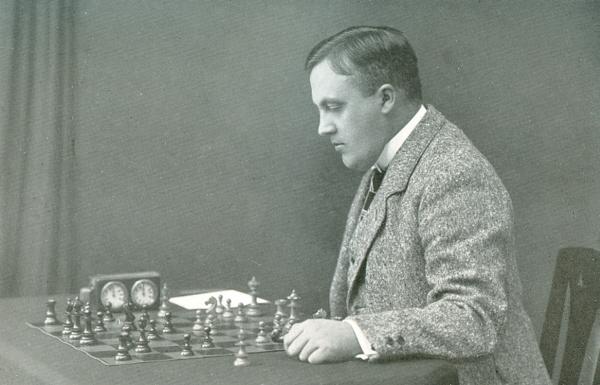
6589. Pomar at London, 1946 (C.N.s 6573 & 6584)
From page 14 of London 1946, published by CHESS (Sutton Coldfield, 1946):
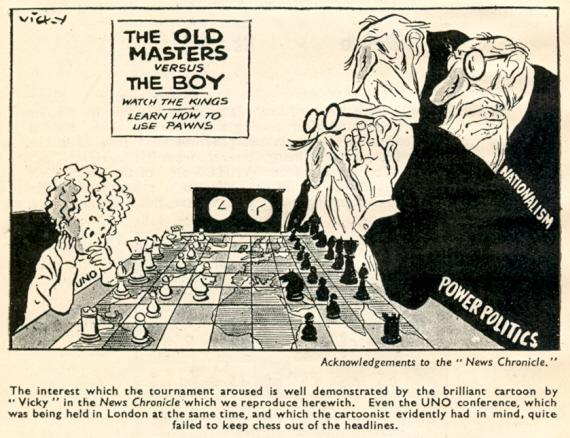
6590. The monkey and the watch
- ‘The great Steinitz is credited with the most devastating reply ever made to a kibitzer. To one who said he failed to understand the moves which Wilhelm had made in a game, that cross, old gentleman replied: “Have you ever seen a monkey examine a watch?”. Page 297 of Chess Review, October 1951 (in an article by B. Hayden). The same text was given on page 20 of Hayden’s book Cabbage Heads and Chess Kings (London, 1960).
- ‘Snarled Steinitz to an onlooker who failed to understand one of his moves and asked a silly question: “Have you ever seen a monkey examine a watch?”’ Page 96 of Grandmasters of Chess by H.C. Schonberg (Philadelphia and New York, 1973).
- ‘Steinitz, however, never did have much patience with hoi polloi, singly or in groups. One anecdote about him concerns a fellow who had the temerity one day to come up to him and remark, “Herr Steinitz, I really cannot understand your play in this game.” “Naturally”, Steinitz is said to have replied. “Did you ever see a monkey toying with a watch?”’ Page 19 of The World Chess Championship A History by A. Horowitz (New York, 1973).
- ‘What game can so obsesses [sic] a human being that he is reduced, as Wilhelm Steinitz once characterized a player, to a chimpanzee toying with a pocket watch.’ Page 5 of Chess to Enjoy by A. Soltis (New York, 1978).
- ‘Cantankerous, irritable, vituperative, Steinitz could be contemptuous of the efforts of others to understand his ideas. “Have you ever seen a monkey examining a watch?”, was his answer to one hapless enquirer.’ Page 67 of The Kings of Chess by W. Hartston (London, 1985).
- ‘Once when a spectator made a stupid remark about a game, he [Steinitz] compared him to a monkey examining a watch.’ Page 16 of Chess by M. Basman (London, 1999).
In reality – as briefly mentioned in C.N. 1077 (see page 125 of Chess Explorations) – the words in question were spoken by Ludolph Schüll of the Liverpool Chess Club and were reported by Amos Burn in the final paragraph of a letter (dated 30 December 1889 and concerning a telegraphic chess code) which was published on pages 36-37 of the February 1890 issue of Steinitz’s International Chess Magazine:
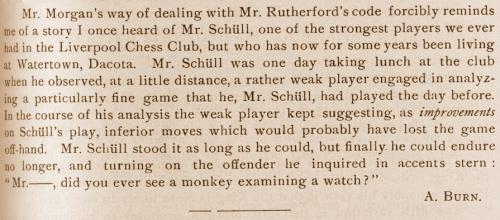
6591. H.E. Bird and railways (C.N. 6558)
Wijnand Engelkes (Zeist, the Netherlands) sends us, courtesy of his colleague Johan Koning ter Heege, two entries concerning Bird on pages 221 and 222 of A Bibliography of British Railway History compiled by George Ottley (London, 1983):


6592. Bronstein in 1953
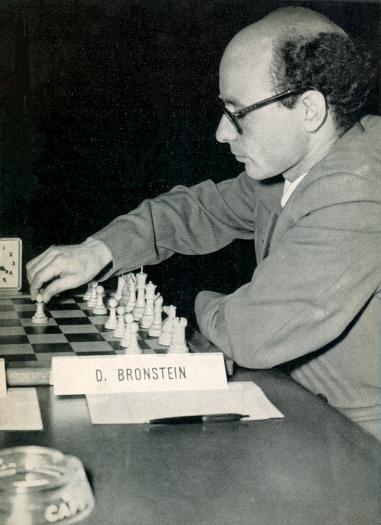
As recorded in the Factfinder, a number of C.N. items have discussed the sales figures of chess books. An addition comes from page 202 of The Sorcerer’s Apprentice by D. Bronstein and T. Fürstenberg (London, 1995), in a text by Boris S. Vainstein originally published in the February 1984 issue of 64:
‘David Bronstein wrote first of all about chess as an art. His book International Grandmaster Tournament, (Candidates’ Tournament, Neuhausen/Zurich 1953, T.F.) of which more than 300,000 copies were sold in this country alone, is not a collection of chess games with commentaries but a real literary work.’
The passage is on pages 226-227 of the revised and expanded edition of The Sorcerer’s Apprentice (Alkmaar, 2009).
C.N. 1949 quoted some remarks made by Bronstein regarding the 1953 tournament book in an interview with Antonio Gude on pages 38-42 of the March 1993 issue of the Revista Internacional de Ajedrez:
‘Most of the nice words and elegant expressions in the book overall are the work of Vainstein, who writes very well ... Of course, the analysis and technical concepts are mine, as are the views on my rivals, but it may be said that a large part of the text is by Vainstein. Also, it is a book for which I do not have particular affection because it reminds me of a tournament that was very special in a negative sense. Things happened there that I should like to forget ... We shall discuss that another time. I do not wish to be more specific for the moment.’
For a subsequent, specific account (entitled ‘Thrown’ games in Zurich) see pages 131-137 of Secret Notes by D. Bronstein and S. Voronkov (Zurich, 2007).
6593. Morphy v Harrwitz
A position from the sixth match-game between Morphy and Harrwitz, Paris, 1858:
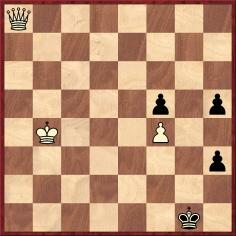
The finish – as given, for instance, on page 61 of Morphy’s Games of Chess by J. Löwenthal (London, 1860) – was 48 Qf3 and wins (‘for if 48...h2 49 Qg3+ Kh1 50 Qf2, mating next move’).
The conclusion was featured in an article ‘Some Historic Blunders’ by W.H. Watts on page 26 of a book co-written by him with A.W. Foster, The Year-Book of Chess 1915 and 1916 (London, 1917):

Page 480 of Staunton’s Chess Praxis (London, 1860) stated that after 48 Qf3 Black resigned, and the faulty line referred to by Watts was given in a footnote:
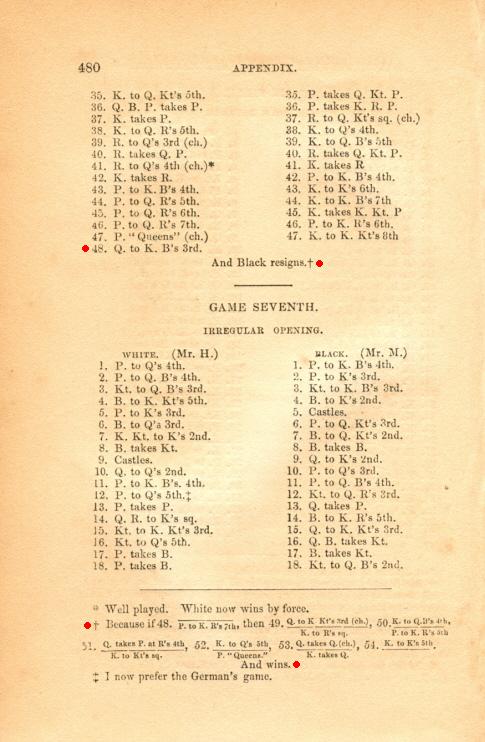
The matter is surprisingly complex, and we would make a number of points:
1) In Chess Praxis the game appeared in a
lengthy ‘Appendix’ (pages 453-620) consisting of
annotated Morphy games, and we are puzzled by a comment
in a review of the book on pages 97-103 of the Chess
Player’s Chronicle, 1860:
‘The third and last part of the book is called the Appendix, and consists of the well-known Morphy games to the number of about 150. These games are prefaced by a few lines which lead us to infer that the work was done by contract – so much for so much. The author says: “The notes to the games in the Appendix are generally taken from the publications in which they at first appeared, and are generally good, although we cannot always approve of the taste which prevailed in the choice of them.[”]’
That is a strange remark for any author to make, but in any case we cannot find the passage in our (1860) edition of Chess Praxis.
2) Staunton published the erroneous analysis in his Illustrated London News column of 9 October 1858 (page 344). We thank Rod Edwards (Victoria, BC, Canada) for a copy:
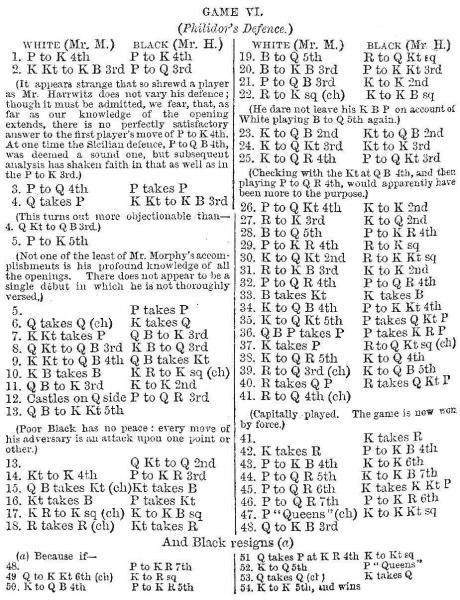
On page 340 of the November 1858 Chess Monthly the analysis by Staunton was repeated (without any indication that it was wrong):
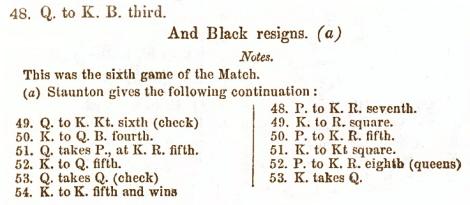
The same text, and still with notation errors, was reproduced on page 36 of Morphy’s Games of Chess, and Frère’s Problem Tournament by T. Frère (New York, 1859):
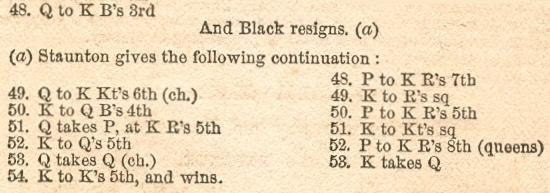
3) The line was given too, without any mention of Staunton, on page 241 of Paul Morphy, A Sketch from the Chess World by Max Lange (London, 1860):
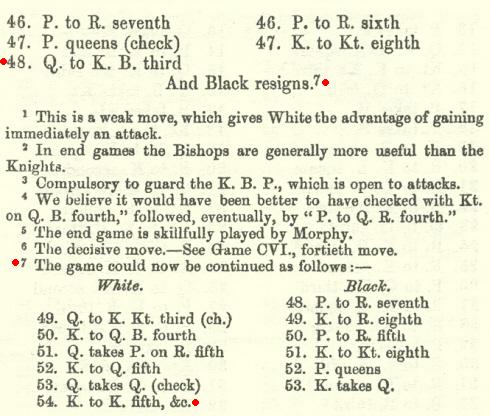
4) Page 109 of Choix des parties les plus remarquables jouées par Paul Morphy en Amérique, en Angleterre et en France by J. Preti (Paris, 1859) gave the same moves but indicated that they were played over the board:

If the Preti book were correct, it would mean that, in the diagrammed position below, Morphy too missed 50 Qf2 and 51 Qf1 mate, during the game.
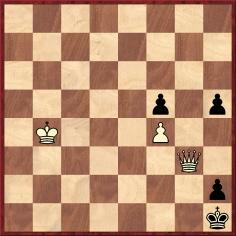
There is surely much more to be discovered about this matter.
6594. François Mitterrand
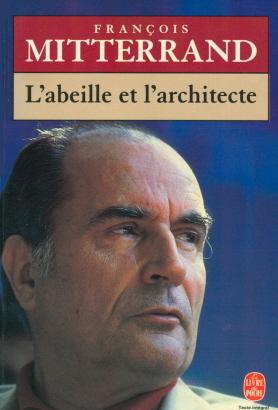
C.N. 2391 remarked that the opening paragraph of L’abeille et l’architecte by François Mitterrand (Paris, 1978) discussed chess:
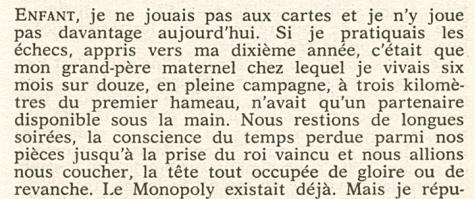
Our earlier item (see page 390 of A Chess Omnibus) gave an English translation.
Other chess references concerning Mitterrand will be welcome. We note this ‘einmal’ quote (with a misspelling of the President’s name) on page 216 of Persönlichkeiten und das Schachspiel by B. Rüegsegger (Huttwil, 2000):
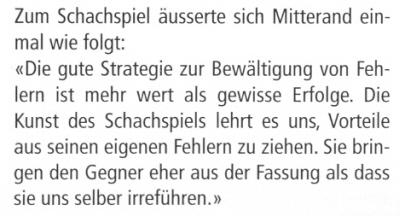
6595. Fischer and blitz
Robert Desjarlais (Bronxville, NY, USA) enquires about the origins of Fischer’s reported statement that ‘blitz kills ideas’.
The best citation that we can currently offer is a second-hand one, on page 308 of the June 1970 Chess Life & Review. Dragoslav Andrić wrote: ‘while Fischer is known for his pronounced years-long aversion to blitz play, which, in his opinion, “kills your ideas”.’

| First column | << previous | Archives [70] | next >> | Current column |
Copyright: Edward Winter. All rights reserved.
